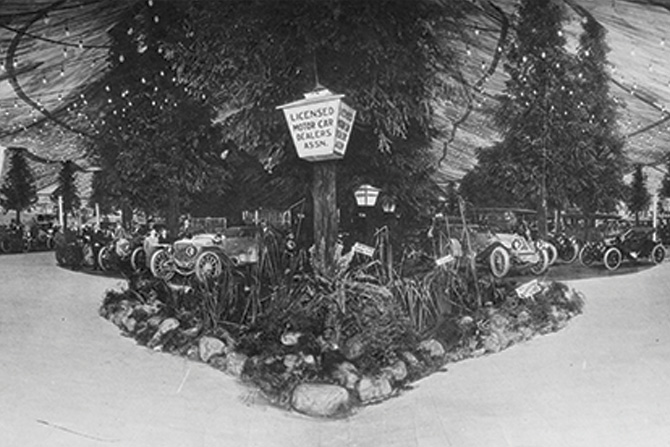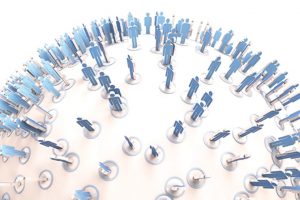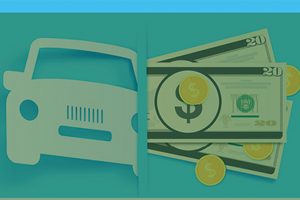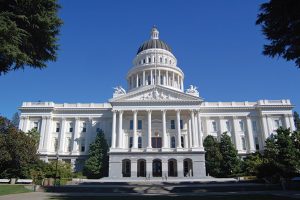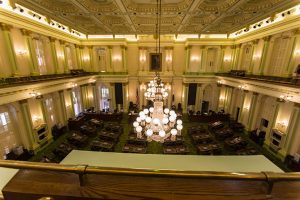Darryl Holter, CNCDA Board Member
Providing Service and Repairs
Neither the early automakers nor the dealers were especially concerned with service and repairs. Dealers focused on selling cars, not repairing them. They kept a few tools in the back of their showrooms but were not equipped to handle even relatively minor repairs. Instead, they referred their customers to local mechanics. The earliest cars were hand-built and assembled from parts purchased from suppliers that were rarely standardized or interchangeable. The factories did not provide manuals for guidance, and repairs were often a matter of guesswork.
When dealers referred customers to nearby mechanics, disagreements between mechanics and customers over the cost or the time required to make repairs often left the problem at the dealer’s doorstep. Dealers often attempted to fill the service gap by providing repairs for no charge within 10 or 30 days, but this often led to disagreements. In 1916 the National Automobile Chamber of Commerce encouraged carmakers to cover the replacement of defective parts for 90 days. Most automakers supported this proposal, but the labor cost for replacing the faulty part and the shipping costs fell to the dealers.
The “Second-Hand Car” Problem
The first buyers were affluent people willing to take a risk on a vehicle with no guarantee that it would perform properly. Early dealers catered to this upscale audience and had no interest in dabbling in “second-hand” vehicles. In 1905, at the second meeting of the Motor Car Dealers of Los Angeles, the members voted “not to trade in any second-hand cars, as part payment on any new machines.”(1) However, as the number of new car sales continued to grow, dealers faced previous customers who needed to sell their used car before purchasing a new one. This situation came to be known as “the second-hand car problem.”
Carmakers set prices for new cars and, concerned about the brand’s image, did not allow dealers to discount. Customers saw the value of their car in retail terms, but dealers, anticipating the need to install new tires, paint, and various repairs, estimated the used car’s value in wholesale terms. This introduced an inherent element of distrust that worked against customer retention. Since dealers needed to sell new cars, they soon disregarded their trade association’s policy and began taking used cars in trade for new car purchases. Each time a used car was taken in on a trade, the dealers had to decide whether to invest in reconditioning or wholesale it to one of the used car operators located on the edges of Auto Row. Calculating the value of a used car was often guesswork. Not only was each used car different from all others, but with more than a hundred brands on the market, dealers knew little about the brands they did not represent. Dealers too often offered discounts that were far greater than what they could sell the car for.(2) The manufacturers focused on new car sales, considered the second-hand car problem one for the dealers to handle.
In 1914 a 17-year-old boy drove from Arkansas to Los Angeles to find work and enter the University of Southern California. To pay for college, he bought cars cheaply and reconditioned and sold them on a lot near USC. He kept track of all purchases and sales of all brands and analyzed the data until he had a much better sense of the value of each make and model. He circulated his list to dealers who began to use his list to show customers the true value of their vehicles. Needing space to grow, he moved his operations to Main Street, then Broadway, then Olive and finally, to the corner of Figueroa and Pico (currently the L.A. Convention Center). Kelly’s Kars became the largest used car operation in the world, and Les Kelley’s Blue Book became the Bible of used car pricing.(3)
California’s First Auto Show
The first auto show in California took place in Los Angeles in 1907 when the Motor Car Dealers voted to organize “an Automobile Show this winter.”(4) According to the Los Angeles Times, the dealers “ask for no aid from the manufacturer associations and stand on their own feet entirely.(5) They decided to conduct the show at the Morley Skating Rink on Grand Avenue near the new auto row of bicycle and automobile dealerships.(6)
The show opened with a large parade of vehicles, and prizes were offered to the best-decorated cars.(7) Dozens of electricians busily installed more than 10,000 electric lighting units strung in long festoons over the ceiling. The dealers scheduled 200 salesmen to answer questions from customers who paid 50 cents to gain admission. Music was provided on the first night by the Ladies Mandolin Orchestra and the Royal Hawaiian Sextet.(8) Ninety-nine cars were displayed the first night. Henry Ford appeared at the show, and its attendance was so high that dealers considered extending it for another week. However, every car on display had been sold and was promised for delivery on Monday, so the idea was abandoned.(9) For several years the dealers managed all aspects of the auto show. But as it became larger and more complicated, they hired a staff professional in 1920 to lead the event. L.A. Auto Show originated with the dealers, not the carmakers.
Dealers Who Made a Difference
William K. Cowan
William K. Cowan’s career shows how the bicycle opened the way to the automobile. In 1892 Cowan participated in organized bike races in the Los Angeles region.(10) He formed a bicycle club and managed the Rambler Bicycle Shop on Spring Street, renting bikes and selling them for cash and installments.(11) He was deeply impressed with the first automobiles and claimed to be the first person to sell a car in Los Angeles in 1899.(12) Within a few years Cowan owned the Rambler Bicycle shop, and when Rambler started making cars, Cowan began selling them.(13) Cowan was a founding member of the Southern California Automobile Club in 1903 and the founding president of the Motor Car Dealers Association of Los Angeles in 1905.(14)
Don Lee
Don Lee demonstrated how early dealers experimented with new ways to reach auto buyers.(15) Lee built an elegant new showroom to attract affluent customers, and when Cadillac expanded his area to the entire state of California, he opened new showrooms in Pasadena, San Francisco and Oakland in 1912.
Cadillac offered women something quite useful in 1911: the electric self-starter. In his advertising, Lee capitalized on this new feature to attract female motorists. Like other dealers, Lee invested heavily in newspaper advertising, but he was especially interested in radio and bought KFRC in San Francisco and KHJ in Los Angeles one year later. His station featured live music and actors who pitched Cadillac. Lee even started a television studio, one of the first of its kind, at Don Lee Cadillac in downtown Los Angeles in 1931. The Federal Radio Commission granted a license to station W6XAO-TV, and it took to the air in December 1931, broadcasting one hour a day, six days a week.
Don Lee was a visionary who identified new opportunities that soon became standard features of auto retailing in America. Lee was also a founding member of the Motor Car Dealers Association of Los Angeles.
Paul G. Hoffman
Paul Hoffman’s story reads like the American Dream. Born in a suburb of Chicago in 1891, young Hoffman was fascinated by the automobile. He got a job repairing cars and, after six months, was promoted to sales. In 1911 he moved to L.A. and sold Studebakers in downtown Los Angeles. A prodigious salesperson, one month he made $1,000 in commissions. In 1912 Hoffman entered an essay contest for Studebaker salespersons. His essay, “How to Sell Studebaker Automobiles,” won first prize, and Hoffman was invited to South Bend, Indiana, where he met with Mr. Studebaker.
Hoffman returned to Los Angeles, became a general manager, then a dealer. He served on the Executive Board of the Traffic Commission of the City and County of Los Angeles. He wrote an article on the traffic problem in Los Angeles that was published in the Annals of the American Academy.(16) Soon Studebaker appointed Hoffman as Vice President. In 1929 he co-wrote a very useful book called Marketing Used Cars that explained how new car dealers should organize their used car departments, how to buy, recondition, and sell used cars, and how to control inventory.(17) In 1934 Hoffman was named president of the Studebaker Corporation.
In 1948, in the aftermath of World War II, President Harry Truman named Hoffman to lead the European Economic Cooperation Administration, generally known as The Marshall Plan, to utilize American assistance to rebuild war-torn Europe. Hoffman’s stellar career shows how many dealers (besides being successful business leaders) became leaders in public service at the local, state and national levels.
Winslow B. Felix
Winslow B. Felix is an L.A. story of ambition, reinvention, success, and tragedy. Born in 1891 in the town of Tucson in the Arizona Territory, Wenceslao was the oldest of seven children. Everyone in the family spoke fluently in English and Spanish. Prior to 1910, young Wenceslao left home for Los Angeles, anglicized his name to become Felix, and sold cars at a Lincoln dealership. He served in the tank corps in World War I. After the war, he was hired as a used car manager at Chevrolet dealership, and by 1921 he had acquired his own Chevrolet dealership on 11th and Olive Street in downtown Los Angeles.
Felix was handsome, charming, and a very talented polo player. He became friends with Pat Sullivan, the creator of the Felix the Cat comic character, and the two decided to cross-market the cat and Chevrolet. Felix provided Sullivan and his friends with good deals on Chevrolets, and Winslow made the cat a store mascot and featured him into advertising and promotional events.(18) A writer for the Los Angeles Times described Winslow Felix in the following terms:
“Probably no other motor-car dealer in Los Angeles is so well known throughout the State at large than is Winslow B. Felix,” wrote the Los Angeles Times. “Drive anywhere you will, in any part of Southern California, and … you’ll see cars sporting the Felix cat emblem. It is said that Felix has come to mean Chevrolet and Chevrolet has come to mean Felix.”(19)
Felix was elected president of the Chevrolet Dealers Association of Los Angeles in 1924.(20) Felix found creative new ways to promote sales. For customers in Hollywood and Beverly Hills who did not want to come downtown to purchase or service their cars, salespersons would attach a three-wheel motorcycle (painted with the figure of the cat) to the desired vehicle, drive it to the home of the customer, leave the car, and drive the motorcycle back to the dealership. He started a ”Trial Purchase Plan” where buyers could drive their new cars for two days and, if they were not satisfied, return the car and get their money back.(21) Felix also customized Chevrolet roadsters and touring cars with special features that made these cars stand out. He sponsored dances, parties, athletic events, auto races and shows, and other events.
Sadly, his love for polo ended in tragedy for Winslow Felix during a polo match at the Riviera Country Club when his horse collided with another, throwing him to the ground. He was taken to the Santa Monica hospital in critical condition with a brain hemorrhage and died the next day.(22)
The career of Winslow B. Felix, the first Mexican-American dealer in Los Angeles and perhaps the nation, is another example of how early dealers developed creative strategies to advance their dealerships and their brands in a very competitive market place.
Darryl Holter
CNCDA Board Member
(1) Motor Car Dealers Association of Southern California, Minutes, June 1, 1905.
(2) Theodore Smith, The Marketing of Used Automobiles, Bureau of Business Research, Ohio State University, April 1941, p. 5.
(3) “Auto Observer”, Los Angeles Times, vol. 1, no. 25, July 26, 1934; ‘Kelley
Blue Book, Inc.” International Directory of Company Histories, vol. 84. “Used Car Dealers Observe Birthday, Los Angeles Times, March 312, 1940; “R. Leslie Kelley, Car-Pricing pioneer, 93,” New York Times, February 11, 1990; R.L. Kelley, First Published Blue Book on Used-Car Values, Los Angeles Times, February 9, 1990.
(4) MCDALA, Minutes, October 19, 1906.
(5) Los Angeles Times, November 11, 1906
(6) MCDALA, Minutes, October 19, 1906.
(7) Los Angeles Times, January 8, 1907.
(8) Los Angeles Times, January 13, 1907.
(9) Los Angeles Times, January 26, 1907.
(10) Los Angeles Herald, July 23 and 27, 1892.
(11) Los Angeles Herald, March 21, 1893 and August 19, 1894.
(12), (13) Motor West, November 1, 1917.
(14) The Horseless Age, July 22, 1903 and Motor Age, June 8, 1905.
(15) On Don Lee, see Greg Fischer, “Don Lee and the Transformation of Los Angeles,” Southern California Quarterly.
(16) Paul G. Hoffman, “The Traffic Commission of Los Angeles: Its Work on the Traffic Problem,” The Annals of the American Academy, —-, pp. 246-250.
(17) Paul G. Hoffman and James E Greene, Marketing Used Cars, Harper and Brothers, New York, 1929, p.11.
(18) “Cats Like the Rain,” Los Angeles Times, March 9, 1924; “You Ought to Hear it Purr: Boss of Felix Pays Visit to His Namesake,” Los Angeles Times, January 11, 1925; “Cats Will Follow These Chevrolets,” Los Angeles Times, February 8, 1925; “Felix the Cat.
(19) “Felix the Cat Makes Business Up to Scratch,” Los Angeles Times, March 29, 1925.
(20) “New Officers are Elected,” Los Angeles Times, May 18, 1924; “Chevrolet Dealers Organize,” Los Angeles Times, August 24, 1924.
(21) “Trial Purchase Plan is Latest Felix Feature,” Los Angeles Times, June 6, 1926.
(22) “Polo Victim: Felix, Auto Man, Injured,” Los Angeles Times, June 1, 1936
This story appears in Issue 3 2020-21 of the California New Car Dealer Magazine.

